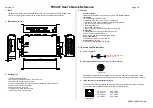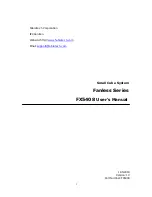
Page 9 of 12
Maintenance
Maintain the product by adopting a program of conscientious repair and maintenance in accordance
with the following recommended procedures. It is recommended that the general condition of any tool
be examined before it is used. Keep your tool in good repair. Keep handles dry, clean, and free from
oil and grease. The following chart is based on a normal operation schedule.
Maintenance Interval
Maintenance Point
Daily before operating
Inspect the strap puller along its full length for fraying, kinks,
broken strands, or distortion. If they appear, the webbing
should be replaced. Also inspect the hook and the load hook
and have them replaced if any damage is noticed.
Keep fingers and hands clear of the ratchet and cable at all
times.
For strap pullers that have not been
used for a long time.
Check all functions of the strap puller, including retracting and
extending, with the strap puller unloaded first. (This puller
may require a small load or pull on the load hook to test
lowering/extending.)
After testing in the unloaded state, attach a 200 Ib. load and
retest to check proper load control and to check brake
operation.
Routinely check the free movement of the stop pawl (4), drive
pawl (6), load hook (11) and the hook (1). Lubricate the puller
at the stop pawl (4), drive pawl (6), load hook (11) and the
hook (1). Always store the strap puller in a safe, dry place
when it is not in use.
Troubleshooting
Use the table below to troubleshoot problems before contacting service personnel or your local
dealer. If the problem continues after troubleshooting, call your local dealer for assistance.
Failure
Possible Cause
Corrective Action
Abnormal noise or vibration
occurs.
Damaged parts.
Check for loose screws, misalignment or
binding of moving parts, cracked, or broken
parts.






























